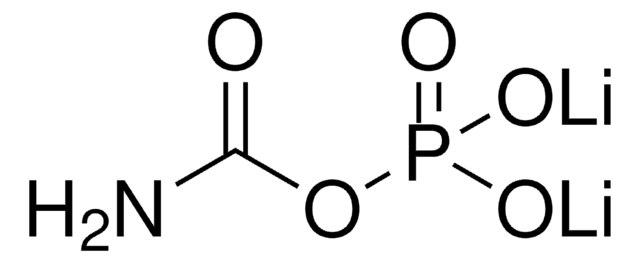A0262
Lithium potassium acetyl phosphate
≥85% (elemental analysis), powder
Synonyme(s) :
Acetyl phosphate lithium potassium salt
About This Item
Produits recommandés
product name
Lithium potassium acetyl phosphate, high-energy phosphate donor
Pureté
≥85% (elemental analysis)
Forme
powder
Pf
>300 °C (lit.)
Solubilité
water: 25 mg/mL, clear, colorless
Température de stockage
−20°C
Chaîne SMILES
[Li+].[K+].CC(=O)OP([O-])([O-])=O
InChI
1S/C2H5O5P.K.Li/c1-2(3)7-8(4,5)6;;/h1H3,(H2,4,5,6);;/q;2*+1/p-2
Clé InChI
RLQMPLKXFIXRCV-UHFFFAOYSA-L
Vous recherchez des produits similaires ? Visite Guide de comparaison des produits
Catégories apparentées
Application
- has been used as a substrate for CpxR (transcription factor) in x-ray crystallography to soak CpxR receiver domain (CpxRRD) crystals to obtain the phosphorylated form
- may be used as a phosphate (P) donor in a study to screen a wide range of natural and synthetic organic phosphate donors with several enzymes on various hydroxyl?compounds for the improved enzymatic synthesis of phosphate monoesters
- has been used to set up premixA for in vitro translation reaction
Actions biochimiques/physiologiques
Mention d'avertissement
Danger
Mentions de danger
Classification des risques
Eye Dam. 1 - Repr. 2 - Skin Corr. 1B
Code de la classe de stockage
8B - Non-combustible corrosive hazardous materials
Classe de danger pour l'eau (WGK)
WGK 3
Point d'éclair (°F)
Not applicable
Point d'éclair (°C)
Not applicable
Équipement de protection individuelle
Eyeshields, Gloves, type N95 (US)
Certificats d'analyse (COA)
Recherchez un Certificats d'analyse (COA) en saisissant le numéro de lot du produit. Les numéros de lot figurent sur l'étiquette du produit après les mots "Lot" ou "Batch".
Déjà en possession de ce produit ?
Retrouvez la documentation relative aux produits que vous avez récemment achetés dans la Bibliothèque de documents.
Les clients ont également consulté
Notre équipe de scientifiques dispose d'une expérience dans tous les secteurs de la recherche, notamment en sciences de la vie, science des matériaux, synthèse chimique, chromatographie, analyse et dans de nombreux autres domaines..
Contacter notre Service technique













